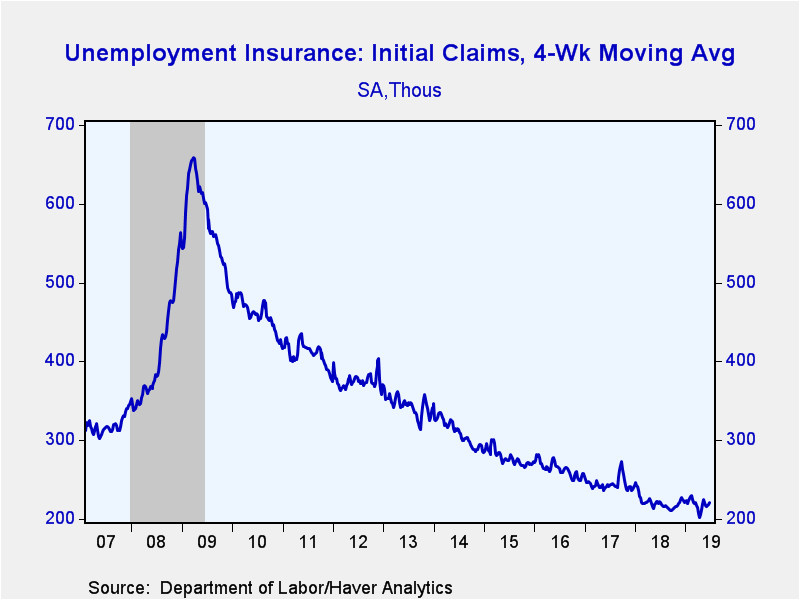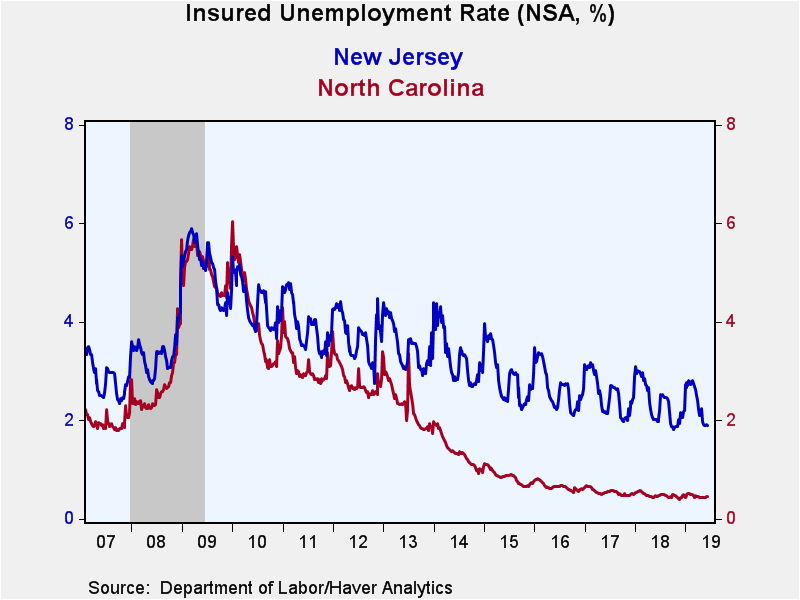 Global| Jun 27 2019
Global| Jun 27 2019U.S. Initial Unemployment Claims Rise, But Not Meaningfully
by:Sandy Batten
|in:Economy in Brief
Summary
Initial unemployment insurance claims decreased to 216,000 in the week ended June 15 Continuing claims for unemployment insurance also decreased, to 1.662 million in the week ending June 8 Initial unemployment insurance claims [...]
Initial unemployment insurance claims decreased to 216,000 in the week ended June 15 Continuing claims for unemployment insurance also decreased, to 1.662 million in the week ending June 8
Initial unemployment insurance claims increased 10,000 to 227,000 in the week ended June 22 from a slightly upwardly revised 217,000 (originally 216,000) the previous week. Claims continue to fluctuate around their lowest level in 50 years, and so this increase is not cause for concern. The consensus expectation from the Action Economics Survey was for claims to total 218,000. The June 22 rise may be somewhat idiosyncratic as it was concentrated in outsized jumps in claims filed in two states, Connecticut and Massachusetts. The four-week moving average of initial claims also rose, to 221,250 from 219,000.
Continuing claims for unemployment insurance increased to 1.688 million in the week ended June 15 from 1.666 million the previous week, which was revised up from 1.662 million initially. The four-week moving average of continuing claims rose 6,500 to 1.687 million. While this figure remains subdued by historical standards, this was the highest four-week average reading since April 13.
The insured unemployment rate remained at a record low of 1.2% in the week ending June 15, where it has been for since May 2018. This weekly series dates back to 1971. Monthly data start in 1949 and the current 1.2% level is also the lowest ever on that basis.
Insured rates of unemployment vary widely by state. In the week ending June 8, the lowest rates were in South Dakota (0.25%), Nebraska (0.41%), Florida (0.41%), Indiana (0.44%), North Carolina (0.45%) and New Hampshire (0.45%). The highest rates were in Pennsylvania (1.64%), Connecticut (1.72%), California (1.76%), New Jersey (1.89%) and Alaska (1.97%). Among the other largest states by population, the rate was 1.00% in Texas, 1.22% in New York and 1.44% in Illinois. These state data are not seasonally adjusted.
Data on weekly unemployment claims going back to 1967 are contained in Haver's WEEKLY database, and they are summarized monthly in USECON. Data for individual states are in REGIONW. The expectations figure is in the AS1REPNA database.
| Unemployment Insurance (SA, 000s) | 06/22/19 | 06/15/19 | 06/08/19 | Y/Y % | 2018 | 2017 | 2016 |
|---|---|---|---|---|---|---|---|
| Initial Claims | 227 | 217 | 222 | 1.8 | 220 | 244 | 262 |
| Continuing Claims | -- | 1,688 | 1,666 | -2.0 | 1,756 | 1,961 | 2,135 |
| Insured Unemployment Rate (%) | -- | 1.2 | 1.2 |
1.2 |
1.2 | 1.4 | 1.6 |
Sandy Batten
AuthorMore in Author Profile »Sandy Batten has more than 30 years of experience analyzing industrial economies and financial markets and a wide range of experience across the financial services sector, government, and academia. Before joining Haver Analytics, Sandy was a Vice President and Senior Economist at Citibank; Senior Credit Market Analyst at CDC Investment Management, Managing Director at Bear Stearns, and Executive Director at JPMorgan. In 2008, Sandy was named the most accurate US forecaster by the National Association for Business Economics. He is a member of the New York Forecasters Club, NABE, and the American Economic Association. Prior to his time in the financial services sector, Sandy was a Research Officer at the Federal Reserve Bank of St. Louis, Senior Staff Economist on the President’s Council of Economic Advisors, Deputy Assistant Secretary for Economic Policy at the US Treasury, and Economist at the International Monetary Fund. Sandy has taught economics at St. Louis University, Denison University, and Muskingun College. He has published numerous peer-reviewed articles in a wide range of academic publications. He has a B.A. in economics from the University of Richmond and a M.A. and Ph.D. in economics from The Ohio State University.










